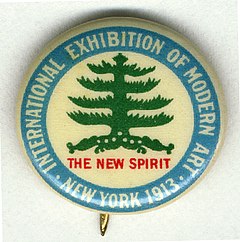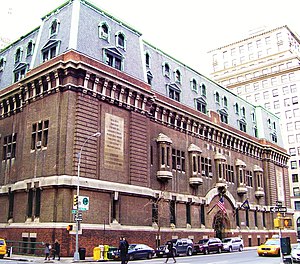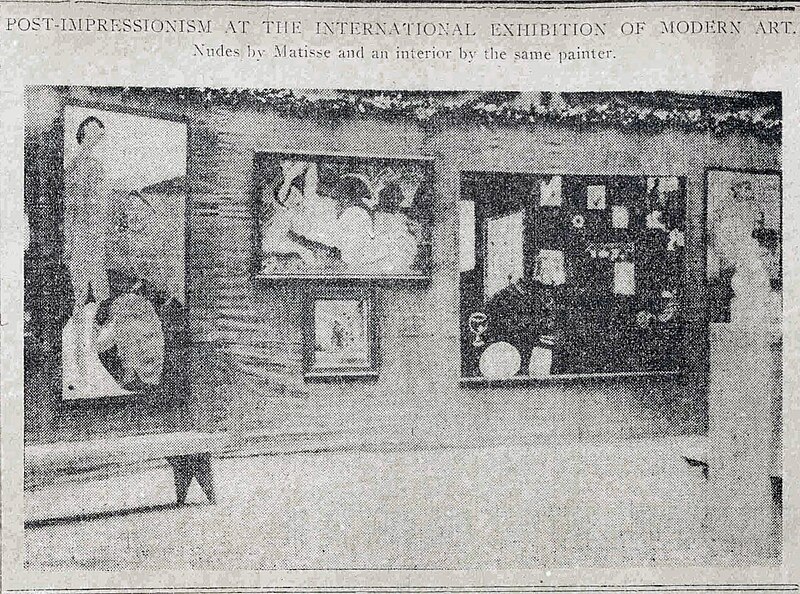Many exhibitions have been held in the vast spaces of U.S. National Guard armories, but the Armory Show refers to the 1913 International Exhibition of Modern Art that was organized by the Association of American Painters and Sculptors, the first large exhibition of modern art in America. The three-city exhibition started in New York City's 69th Regiment Armory, on Lexington Avenue between 25th and 26th Streets, from February 17 until March 15, 1913. The exhibition went on to show at the Art Institute of Chicago and then to The Copley Society of Art in Boston, where, due to a lack of space, all the work by American artists was removed. The show became an important event in the history of American art, introducing astonished Americans, who were accustomed to realistic art, to the experimental styles of the European avant garde, including Fauvism, Cubism, and Futurism. The show served as a catalyst for American artists, who became more independent and created their own "artistic language."
History

On 14 December 1911 an early meeting of what would become the Association of American Painters and Sculptors (AAPS) was organized at Madison Gallery in New York. Four artists met to discuss the contemporary art scene in the United States, and the possibilities of organizing exhibitions of progressive artworks by living American and foreign artists, favoring works ignored or rejected by current exhibitions. The meeting included Henry Fitch Taylor, Jerome Myers, Elmer Livingston MacRae and Walt Kuhn.
In January 1912, Walt Kuhn, Walter Pach, and Arthur B. Davies joined together with some two dozen of their colleagues to reinforce a professional coalition: AAPS. They intended the organization to "lead the public taste in art, rather than follow it." Other founding AAPS members included D. Putnam Brinley, Gutzon Borglum, John Frederick Mowbray-Clarke, Leon Dabo, William J. Glackens, Ernest Lawson, Jonas Lie, George Luks, Karl Anderson, James E.Fraser, Allen Tucker, and J. Alden Weir. AAPS was to be dedicated to creating new exhibition opportunities for young artists outside of the existing academic boundaries, as well as to providing educational art experiences for the American public. Davies served as president of AAPS, with Kuhn acting as secretary.
The AAPS members spent more than a year planning their first project: the International Exhibition of Modern Art, a show of giant proportions, unlike any New York had seen. The 69th Regiment Armory was settled on as the main site for the exhibition in the spring of 1912, rented for a fee of $5,000, plus an additional $500 for additional personnel. It was confirmed that the show would later travel to Chicago and Boston.
Once the space had been secured, the most complicated planning task was selecting the art for the show, particularly after the decision was made to include a large proportion of vanguard European work, most of which had never been seen by an American audience. In September 1912, Kuhn left for an extended collecting tour through Europe, including stops at cities in England, Germany, the Netherlands, and France, visiting galleries, collections and studios and contracting for loans as he went. While in Paris Kuhn met up with Pach, who knew the art scene there intimately, and was friends with Marcel Duchamp and Henri Matisse; Davies joined them there in November 1912. Together they secured three paintings that would end up being among the Armory Show’s most famous and polarizing: Matisse’s “Blue Nude (Souvenir de Biskra)†and “Madras Rouge (Red Madras Headdress),â€and Duchamp’s “Nude Descending a Staircase, No. 2.†Only after Davies and Kuhn returned to New York in December did they issue an invitation for American artists to participate.
Pach was the only American artist to be closely affiliated with the Section d'Or group of artists, including Albert Gleizes, Jean Metzinger, Duchamp brothers Marcel Duchamp, Raymond Duchamp-Villon, Jacques Villon and others. Pach was responsible for securing loans from these painters for the Armory Show. Most of the artists in Paris who sent works to the Armory Show knew Pach personally and entrusted their works to him.
The Armory Show was the first, and, ultimately, the only exhibition mounted by the AAPS. It displayed some 1,300 paintings, sculptures, and decorative works by over 300 avant-garde European and American artists. Impressionist, Fauvist, and Cubist works were represented. News reports and reviews were filled with accusations of quackery, insanity, immorality, and anarchy, as well as parodies, caricatures, doggerels and mock exhibitions. About the modern works, former President Theodore Roosevelt declared, "That's not art!" The civil authorities did not, however, close down, or otherwise interfere with, the show.
Among the scandalously radical works of art, pride of place goes to Marcel Duchamp's cubist/futurist style Nude Descending a Staircase, painted the year before, in which he expressed motion with successive superimposed images, as in motion pictures. Julian Street, an art critic, wrote that the work resembled "an explosion in a shingle factory" (this quote is also attributed to Joel Spingarn), and cartoonists satirized the piece. Gutzon Borglum, one of the early organizers of the show who for a variety of reasons withdrew both his organizational prowess and his work, labeled this piece A staircase descending a nude, while J. F. Griswold, a writer for the New York Evening Sun, entitled it The rude descending a staircase (Rush hour in the subway). The painting was purchased from the Armory Show by Fredric C. Torrey of San Francisco .
The purchase of Paul Cézanne's Hill of the Poor (View of the Domaine Saint-Joseph) by the Metropolitan Museum of Art signaled an integration of modernism into the established New York museums, but among the younger artists represented, Cézanne was already an established master.
Duchamp's brother, who went by the "nom de guerre" Jacques Villon, also exhibited, sold all his Cubist drypoint etchings, and struck a sympathetic chord with New York collectors who supported him in the following decades.
The exhibition went on to show at the Art Institute of Chicago and then to The Copley Society of Art in Boston, where, due to a lack of space, all the work by American artists was removed.
While in Chicago, the exhibition created a scandal that reached the governors office. Several articles in the press recounted the issue. In one newspaper the headline read: Cubist Art Will be Investigated; Illinois Legislative Investigators to Probe the Moral Tone of the Much Touted Art:
Chicago, April 2: Charges that the international exhibition of cubist and futurist pictures, now being displayed here at the art institute, contains many indecent canvasses and sculptures will be investigated at once by the Illinois legislature white slave commission. A visit of an investigator to the show and his report on the pictures caused Lieutenant Governor Barratt O'Hara to order an immediate examination of the entire exhibition. Mr. O'Hara sent the investigator to look over the pictures after he had received many complaints of the character of the show. "We will not condemn the international exhibit without an impartial investigation," said the lieutenant governor today. "I have received many complaints, however, and we owe it to the public that the subject be looked into thoroughly." The investigator reported that a number of the pictures were "immoral and suggestive." Senators Woodward and Beall of the commission will visit the exhibition today. (Ottumwa Tri-Weekly Courier, Iowa, 3 April 1913)
Floor plan

Tour the galleries
- Gallery A: American Sculpture and Decorative Art
- Gallery B: American Paintings and Sculpture
- Gallery C, D, E, F: American Paintings
- Gallery G: English, Irish and German Paintings and Drawings
- Gallery H, I: French Painting and Sculpture
- Gallery J: French Paintings, Water Colors and Drawings
- Gallery K: French and American Water Colors, Drawings, etc.
- Gallery L: American Water Colors, Drawings, etc.
- Gallery M: American Paintings
- Gallery N: American Paintings and Sculpture
- Gallery O: French Paintings
- Gallery P: French, English, Dutch and American Paintings
- Gallery Q: French Paintings
- Gallery R: French, English and Swiss Paintings
Legacy

The original exhibition was an overwhelming success. There have been several exhibitions that were celebrations of its legacy throughout the 20th century.
In 1944 the Cincinnati Art Museum mounted a smaller version, in 1958 Amherst College held an exhibition of 62 works, 41 of which were in the original show, and in 1963 the Munson-Williams-Proctor Arts Institute in Utica, New York organized the "1913 Armory Show 50th Anniversary Exhibition" sponsored by the Henry Street Settlement in New York, which included more than 300 works.
Experiments in Art and Technology (E.A.T.) was officially launched by the engineers Billy Klüver and Fred Waldhauer and the artists Robert Rauschenberg and Robert Whitman when they collaborated in 1966 and together organized 9 Evenings: Theatre and Engineering, a series of performance art presentations that united artists and engineers. Ten artists worked with more than 30 engineers to produce art performances incorporating new technology. The performances were held in the 69th Regiment Armory, as an homage to the original and historical 1913 Armory show.
In February 2009, the Art Dealers Association of America (ADAA) presented its 21st annual Art Show to benefit the Henry Street Settlement, at the Seventh Regiment Armory, located between 66th and 67th Streets and Park and Lexington Avenues in New York City. The exhibition began as a historical homage to the original 1913 Armory Show.
Starting with a small exhibition in 1994, by 2001 the "New" New York Armory Show, held in piers on the Hudson River, evolved into a "hugely entertaining" (New York Times) annual contemporary arts festival with a strong commercial bent. The 2008 and 2009 Armory Shows did not hold back on the more crude and vulgar works, which are not unknown for the show, which has been less tame in past years.
Commemorating the Centennial

Five physical exhibitions in 2013 celebrate the 100th anniversary of the 1913 Armory Show, as well as a number of publications, virtual exhibitions, and programs. The first exhibition, “The New Spirit: American Art in the Armory Show, 1913,†opens at the Montclair Art Museum on Feb. 17, 2013, a hundred years to the day from the original. The second exhibition will be organized by the New-York Historical Society, titled "The Armory Show at 100," which will take place from October 18, 2013 through February 23, 2014. The Smithsonian's Archives of American Art, which lent dozens of historic documents to both the New York Historical Society and Montclair for the exhibitions, has created an online timeline of events, 1913 Armory Show: the Story in Primary Sources, to showcase the records and documents created by the show's organizers. Showing contemporary work, a third exhibition, The Fountain Art Fair, was held at the 69th Regiment Armory itself during the 100th anniversary during March 8â€"10, 2013. The ethos of Fountain Art Fair was inspired by Duchamp's famous, "Fountain" which was the symbol of the Fair. The Art Institute of Chicago, which was the only museum to host the 1913 Armory Show, presented works February 20 â€" May 12, 2013, the items drawn from the museum's modern collection that were displayed in the original 1913 exhibition. The DePaul Art Museum in Chicago, Illinois will be presented For and Against Modern Art: The Armory Show +100, from April 4 to June 16, 2013. In addition, the Greenwich Historical Society will present The New Spirit and the Cos Cob Art Colony: Before and After the Armory Show, from October 9, 2013, through January 12, 2014. The show will focus on the effects of the Armory Show on the Cos Cob Art Colony, and highlight the involvement of artists such as Elmer Livingston MacRae and Henry Fitch Taylor in producing the show.
American filmmaker Michael Maglaras produced a documentary film about the Armory Show entitled, "The Great Confusion: The 1913 Armory Show". The film premiered on September 26, 2013, at the New Britain Museum of American Art in New Britain, Connecticut.
List of artists

Below is a partial list of the artists in the show. These artists are all listed in the 50th anniversary catalog as having exhibited in the original 1913 Armory show.
List of women artists

The List of women artists in the Armory Show includes women artists from the United States and from Europe who were exhibited in the Armory Show of 1913. Approximately 1/5 of the artists showing at the armory were women, many of whom have since been neglected.
Images

Selected painting and sculpture

Special installation
La Maison Cubiste (Cubist House)
At the 1912 Salon d'Automne an architectural installation was exhibited that quickly became known as Maison Cubiste (Cubist House), signed Raymond Duchamp-Villon and André Mare along with a group of collaborators. Metzinger and Gleizes in Du "Cubisme", written during the assemblage of the "Maison Cubiste", wrote about the autonomous nature of art, stressing the point that decorative considerations should not govern the spirit of art. Decorative work, to them, was the "antithesis of the picture". "The true picture" wrote Metzinger and Gleizes, "bears its raison d'être within itself. It can be moved from a church to a drawing-room, from a museum to a study. Essentially independent, necessarily complete, it need not immediately satisfy the mind: on the contrary, it should lead it, little by little, towards the fictitious depths in which the coordinative light resides. It does not harmonize with this or that ensemble; it harmonizes with things in general, with the universe: it is an organism...". "Mare's ensembles were accepted as frames for Cubist works because they allowed paintings and sculptures their independence", writes Christopher Green, "creating a play of contrasts, hence the involvement not only of Gleizes and Metzinger themselves, but of Marie Laurencin, the Duchamp brothers (Raymond Duchamp-Villon designed the facade) and Mare's old friends Léger and Roger La Fresnaye". La Maison Cubiste was a fully furnished house, with a staircase, wrought iron banisters, a living roomâ€"the Salon Bourgeois, where paintings by Marcel Duchamp, Metzinger (Woman with a Fan), Gleizes, Laurencin and Léger were hungâ€"and a bedroom. It was an example of L'art décoratif, a home within which Cubist art could be displayed in the comfort and style of modern, bourgeois life. Spectators at the Salon d'Automne passed through the full-scale 10-by-3-meter plaster model of the ground floor of the facade, designed by Duchamp-Villon. This architectural installation was subsequently exhibited at the 1913 Armory Show, New York, Chicago and Boston, listed in the catalogue of the New York exhibit as Raymond Duchamp-Villon, number 609, and entitled "Facade architectural, plaster" (Façade architecturale).
Sources

- Sarah Douglas. "Pier Pressure." March 26, 2008. Archived on April 11, 2008.
- Catalogue of International Exhibition of Modern Art, at the Armory of the Sixty-Ninth Infantry, Feb. 15 to Mar. 15, 1913. Association of American Painters and Sculptors, 1913.
- Walt Kuhn. The Story of the Armory Show. New York, 1938.
- Milton W. Brown. The Story of the Armory Show. Joseph H. Hirshhorn Foundation, distributed by New York Graphic Society, 1963. [republished by Abbeville Press, 1988.]
- 1913 Armory Show 50th Anniversary Exhibition. Text by Milton W. Brown. Utica: Munson-Williams-Proctor Institute, 1963.
- Walter Pach Papers, Archives of American Art, Smithsonian Institution
- Walt Kuhn, Kuhn Family Papers, and Armory Show Records, Archives of American Art, Smithsonian Institution
See also
- List of artists in the Armory Show
- List of women artists in the Armory Show
- Experiments in Art and Technology
- American modernism
- American realism
- Ashcan school
- Culture of New York City
- The Armory Show (art fair)
References
External links
1913 Armory Show
- The Armory Show at 100: Modern Art and Revolution, The New-York Historical Society
- Smithsonian, Archives of American Art, Walt Kuhn scrapbook of press clippings documenting the Armory Show, vol. 2, 1913. Armory Show catalogue (illustrated) from pages 159 through 236
- Catalogue of international exhibition of modern art Association of American Painters and Sculptors. Published 1913 by the Association in New York
- NPR, Armory Show that shocked America in 1913 celebrates 100
- 1913 Armory Show: the Story in Primary Sources, Archives of American Art, Smithsonian Institution
- The New Spirit: American Art in the Armory Show, 1913 at the Montclair Art Museum, February 17 - June 16, 2013
- Virtual re-creation of the Armory Show from the American Studies Programs at the University of Virginia
- The 1913 Armory Show, askart essay
Armory shows after 1913
- The "New" Armory Show
- Artkrush.com feature on the 2006 Armory Show (March, 2006)
- 2010 Armory Show
- Swann Galleries - The Armory Show at 100 - Exhibition through November 5, 2013
- Armory Show 2014: List of exhibiting galleries
